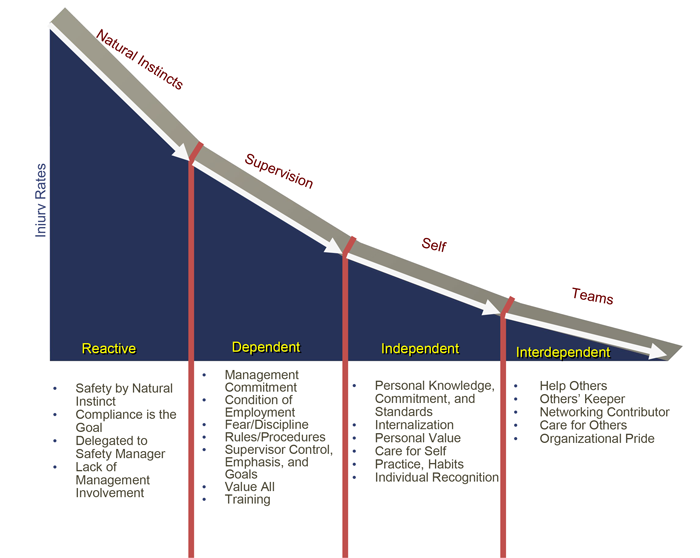How to improve safety culture through sub-committees
Thursday, 29 November 2018
Debasis Guha is Departmental Head of Corporate Safety at UltraTech Cement Ltd in India and holder of the NEBOSH International Diploma in Occupational Health & Safety. In this guest column he shares his experiences of using sub-committees to improve health and safety performance.
Safety culture is often described as the shared beliefs, attitudes and behaviours of an organisation about H&S. There are many ways to categorise culture and, even when we do, it is a mistake to think that culture is the same across an organisation (all teams, sites, countries). Culture can be influenced and developed.
Based on my experience of working in such organisations, I will share my learning of shifting the OHS culture from “independent” to “interdependent” (as described in “Bradley Curve”) wherein teams (not individuals):
- help others
- act as others’ keeper
- play the role of networking contributor
- care for others
- feel organisational pride

Here at UltraTech Cement Ltd we have a number of committees and boards that make up the OHS organisational structure:
- Corporate Occupational Health and Safety Board
Chaired by the Business Head, this Board meets every two months to review OHS performance of the organization as a whole and decide actions for further improvement. - Unit Apex OHS Committee
Led by the Unit (Site) Head, these committee’s meet on a monthly basis to review each the safety performance of each of our 30 sites. - Corporate and Unit Sub-Committees
We have established seven sub-committees that operate at both corporate and unit level (detailed below).
Sub-Committees
The creation of sub-committees has helped to drive consistency/uniformity across the business and strengthen major elements of our OHS management system.
There are 7 main sub-committees, listed below (further details of their responsibilities are available at the end of this document):
- Standards, Rules and Procedures
- Training and Capability Building
- Contractor Safety Management
- Safety Observation and Audit
- Incident Investigation
- Transport Safety
- Occupational Health
To ensure active involvement and instill a sense of ownership, these sub-committees comprise of people from various line functions. Good practice from these sub-committees is shared across the business.
Benefits
Since the introduction of these sub-committees, we’ve reaped many benefits. There’s increased buy-in from sub-committee members and understanding that safety is the responsibility of the line function. By positioning senior managers as chair of these groups we have seen less conflict of priorities between production and safety and allocation of health and safety resources is no longer an issue. Last but not least, we’ve improved ownership and accountability by teams; all major elements of health and safety are being managed in a more effective manner which has led to improved performance of both leading and lagging indicators.
For example, safety training man-hours (one of the leading indicators) has doubled and lost time incident frequency rate (one of the lagging indicators) has reduced to one-third.
Sub-committee responsibilities
Standards, Rules and Procedures
- Develop, review, implement and communicate safety standards, rules and procedures.
- Identify areas where standards and procedures need to be evolved and communicate to Board-level sub-committee.
- Implement audit protocols for all standards at each line function.
Training and Capability Building
- Identify training needs for different standards for employees and contract workmen by line managers.
- Identifyinternal trainers and train the trainers.
- Based on Training Need Identification, ensure 100% training for permanent and contractor employees on safety standards in phased manner and ensure periodic refresher training.
- Showing videos on safety standards at various sections e.g. “Training on Wheels (mobile vehicle)” to sustain awareness.
Contractor Safety Management
- Implement a six-step process of contractor safety management.
- Ensure contractor’s safety capability building.
- Schedule and conduct CFSA (Contractor Field Safety Audits) .
- Issue red notices for violations (high severity) observed during CFSA.
- Ensure contractor workers go through mandatory
i) Pre medical examination, ii) Trade test iii) Safety Induction before issuance of gate pass.
Safety Observation and Audit
- Ensure effective implementation of Safety Observation (SO) and First Party Safety Audit (FPSA) process.
- Develop action points from the findings of FPSA.
- Ensure training and competency of employees on Safety Observation Process and of FPSA auditors by coordinating with T&C sub-committee.
- Review and monitor compliance of observations/ findings raised through the processes of S.O., FPSA periodically.
- Review and monitor performance of Safety Observation process, Quality of Safety Observation Process implementation at units through the identified KPIs and present the data to the OH&S Board through Business Safety Head.
Incident Investigation
- To ensure reporting of all the incidents including near misses.
- Develop and implement an incident investigation procedure consistently across all sites and
- facilitate training of line managers in quality incident investigation.
- Communicate significant incidents, along with recommendations for correction/prevention across the organisation.
- Identify and analyse incident trends and brief site apex committee and monitor/track to ensure timely closure of recommended actions.
Transport Safety
- Ensure all the vehicles engaged for business are with mandatory gadgets like reverse horn, rear view mirror, seat belts etc.
- Ensure statutory documents like registration, license, fitness certificate, insurance, PUC (Pollution under control) etc.
- Ensure timely reporting of vehicular incidents.
- Take declarations from transporters and commitment from drivers for safe driving.
- Implement reward and recognition initiatives for safe drivers and ensure defensive driving training programs for drivers on regular basis.
Occupational Health
- Ensuring provision of adequate resources for occupational health,
- Identifying occupational health hazards and managing associated risks to be contained to as low as reasonably practicable (ALARP) level.
- Ensuring adequate emergency response capability for medical emergency.
- Measuring/ monitoring health surveillance, sickness and absenteeism, rehabilitation and recovery programs.
- Fostering awareness through health education, training and promotional activities.
